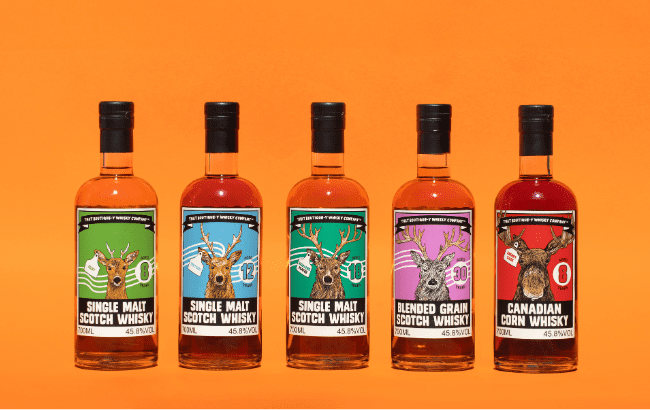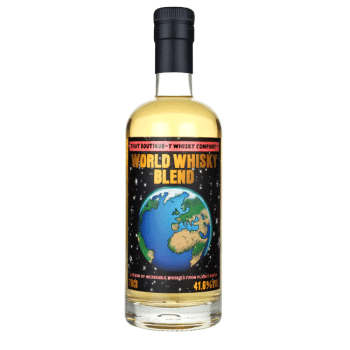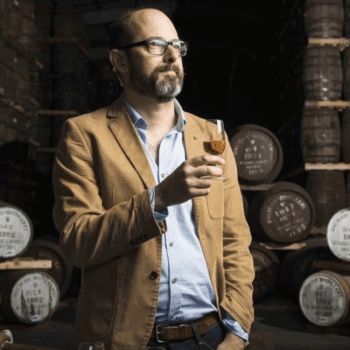Sam Simmons on making blends cool again
By Rupert HohwielerThat Boutique-y Whisky Company’s head of whisky, Sam Simmons, tells us about the challenge of making blends “as cool as single malts”.

Boutique-y Whisky Company (TBWC) has done its fair share of blends: Empire Rye, World Whisky Blend and Out of This World Whisky Blend. But although a “believer in blends and blending”, Simmons believes there is a lot of work to be done in the mind of whisky drinkers that gives the style premium value and that it is still a “hard sell”.
He says one method that could bring about this change is putting a shine on the blenders rather than the distillery itself, such as how Dewar’s does it with its master blender Stephanie Macleod.
“Look at the 36 Double Double, one of the nicest whiskies I’ve ever had. That’s only achievable through the great skill of the blender Stephanie Macleod, and the fact that it’s blended, flavours from all over, at different ages.
“I do think the first step to making that work is making the blender what we’re buying, not the distillery. It’s not about Aberfeldy, it’s about Stephanie Macleod. This multi-award-winning blender, who is creating from the greatest warehouses that she has because of Dewar’s owning all these different distilleries, beautiful distilleries – and the mature stock that she can pull from.
“Making the hero of the maker, that probably is one way to get blends cool again.”
TBWC’s creative freedom over its own labelling and designs is another method that Simmons hopes can make blends more fashionable for the consumer, or at least highlight the fun that blends can bring.
He says: “There is a Scottish guy who does goofy-like football commentary of old matches. His name is Allaster McKallaster and we did a blended whisky (The McKallaster Edition) with him on the label. We know him and he’s funny, and it’s funny – we made the whisky to taste like you might expect from an off-license in the 1970s, like when blended Scotch was the only option. We tried to make that kind of flavour.
“Blends are still a hard sell and there’s an uphill battle to make blends as cool as single malts, but they’re fun to do and I think it’s the greatest art form of whisky for sure.
“We also shouldn’t forget though that blends are still like over 90% of the whisky market. Some brands sell as many bottles in a year as all of single malt sells in a year.”
Age needed for navigation
Age statements are becoming the common way to define premium in whisky and Simmons feels that they are needed but at the same time, the industry has “sort of accidentally hurt itself with age” as “it’s not the most inclusive major”.

He explains: “With Scotch whisky, that is what set the standard for the world, really, in their expectation. Ageing whisky has a disproportionate value. Say you find an eight-year-old whisky at Tesco or on your favourite online retailer for £30, that is a really good price. But then follow that math and you’d think a 40-year-old whisky therefore should be £150, but it’s not. That is not how it works.
“I understand what Scotch has done is really devalued age. It would be great if world distilleries could say ‘this is our three-, four-, five-year-old’ and those were as rare as saying 30-, 40- and 50-year-old Scotch. Because the climate does come into it, but this massive devaluation or premiumisation of the older stuff, there’s been a real coming down of eight years of liquidity.”
He does add though, that age statements remain the “best shorthand for quality”.
“How do you compare a Hellyers Road in Australia to a Holyrood in Edinburgh? You need something and without age, I think a complicated category can actually be even more complicated. A necessary evil makes it sound evil, it’s not, but I think it is still needed.”
Expanding core range
The current TBWC core range leans towards Scotch, but in the future, Simmons says he is “planning to do more core whiskies looking to America, Ireland, England, Taiwan and India”.
A year ago, the company launched its core range with five whiskies consistently available by a regional theme – such as from Islay, Speyside and the Scottish Highlands – with a “less is more” approach.
Alongside its limited editions, Simmons says that he will aim to get Irish, English and Bourbon high-age statement whiskies into the company’s core range over the next year, and that he’s also just acquired “two beautiful casks from Taiwan.”
Additionally, he notes that the company is doing 700ml bottles for the first time, as the company typically bottles its whisky in a 500ml format.
With producers looking to broadcast more of the uniqueness and quality of liquid rather than just their country of origin, to further distinguish themselves, Simmons says he gets that but he also thinks that it’s important to still showcase where you’re from.
“When you look at other regions and why they make whisky in their country, it’s because they were in love with Scotch and to them, Scotland is a far away land. Part of the appeal was this exotic landscape of a very different colour, with deer, rolling hills and streams. I understand being more than just an American whiskey, for example, but it’s still important to be able to say we are Colorado whiskey, or a Texan whiskey, or a Pennsylvanian rye.

“It’s important to be able to define like that and to be able to navigate within a confusing category where, you know, all these new places, they don’t have age statements. It’s hard to navigate without being able to go ‘ah, the Taiwanese whisky’ or ‘oh, did you try the Indian’ – without those cues.
“I do think it can be pretty easy to just blend into the background, so I hope they give that up too easily.”
While more world whisky is the plan for next year, Simmons adds that he is still “so excited to see all the new and exciting things going on in Scotland, even though it is sort of the old world”.
“I went to see Rosebank, which is an old closed distillery, but they rebuilt it. I highly recommend people go visit. I have a real emotional connection to Edinburgh, because that’s where my whole working life started, but Holyrood Distillery… wicked people again. The spirit tastes just beautiful and complex and strange, wild and new and really cool.
“I don’t think I have been more excited about the future of whiskey than when I visited InchDairnie in Fife. They make rye whiskey and rye malt (it has to be called single grain, but it’s made of rye). Scott Sneddon (managing director) is a scientist and an engineer but he loves whisky. So it’s like fusing the past with the resources of the present to make different types of spirits and different mash bills. Rye whisky, oat whisky and Irish pot still-style whisky. It’s just wow.
“The guy is a whisky nerd and a science nerd, which is a great combination, because he’s pursuing all the things we love about traditional whiskies with the technical and scientific knowhow of the 21st century. It’s an awesome visit and I think I’m very excited about what they’re putting out.”
In September, Simmons also appeared on The Spirits Business Podcast where he discussed the value of independent whisky bottlers. You can click here to listen to the episode.
Related news
Macleans mark world record row with 34YO whisky
